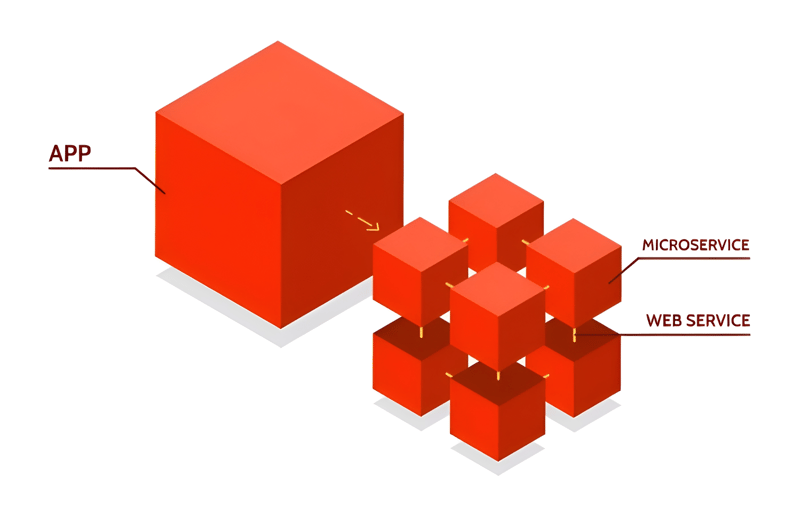Discovering the Magic of Service Mesh: Navigating the Microservices Maze 🌐🕸️🕵️♂️

Panchanan Panigrahi
Posted on February 12, 2024

Welcome to the fascinating world of microservices, where agility and scalability rule. As you start this exciting journey, you encounter the Microservices Maze – a complex network of interdependent services. Fear not! Meet the hero of our story: the Service Mesh. Let's unravel its mysteries and explore why it's a game-changer in the world of microservices.
Microservices: A Quick Recap 🔄
Microservices architecture transforms application development by breaking down big applications into small, independently deployable services. Each service works in its own container, talking to others to create a dynamic and scalable environment. However, this newfound agility brings challenges that the Service Mesh aims to solve.
Introducing the Service Mesh 🕸️
Definition: A Service Mesh is a dedicated infrastructure layer that handles communication between microservices. Think of it as the silent guardian, ensuring smooth interaction while solving common microservices challenges.
Now, let's dive into the Microservices Maze and understand how the Service Mesh tackles real-world problems:
1. Service Discovery – Finding Needles in the Haystack 📍
- Challenge: With services dynamically scaling, manual discovery becomes impractical. Developers struggle to keep track of service locations and configurations.
- Service Mesh Solution: Automated service discovery! Services register themselves with the Service Mesh, which maintains an up-to-date registry. This ensures that services can locate and communicate with each other effortlessly.
2. Load Balancing – Balancing the Load, Not the Headache ⚖️
- Challenge: Uneven traffic distribution can lead to performance bottlenecks and resource wastage.
- Service Mesh Solution: Intelligent load balancing! The Service Mesh dynamically distributes incoming requests across multiple instances of a service, optimizing resource utilization and enhancing system reliability.
3. Fault Tolerance – Shielding Against Microservices Mayhem 🛡️
- Challenge: Microservices are prone to failures due to network issues, timeouts, or resource constraints. A single failure can cascade and affect the entire application.
- Service Mesh Solution: Fault tolerance mechanisms! The Service Mesh employs circuit-breaking, retries, and timeouts to isolate failures and prevent them from propagating across the system. This ensures that the application remains resilient even in the face of adversity.
4. Security – Fortifying the Microservices Fortress 🔐
- Challenge: Ensuring secure communication between microservices is essential to protect sensitive data and prevent unauthorized access.
- Service Mesh Solution: Centralized security policies! The Service Mesh manages encryption, certificates, and access control for all communication between microservices. This ensures that data remains confidential and integrity is maintained throughout the communication process.
5. Observability – Illuminating the Microservices Dark Corners 🔍
- Challenge: Debugging and monitoring distributed microservices can be challenging, especially when issues span multiple services.
- Service Mesh Solution: Enhanced observability features! The Service Mesh provides tools for distributed tracing, metrics collection, and logging. Developers gain insights into the performance and behavior of microservices, facilitating effective debugging, monitoring, and troubleshooting.
6. Traffic Management and A/B Testing – Navigating the Deployment Rapids 🚀
- Challenge: Controlling traffic between different service versions during deployments and testing can be complex and error-prone.
- Service Mesh Solution: Controlled traffic management! The Service Mesh enables gradual rollouts, canary deployments, and A/B testing by allowing developers to route traffic based on predefined rules and criteria. This ensures smooth transitions and minimal impact on end users.
7. Polyglot Environments – Bridging Language Barriers 🌐
- Challenge: Microservices may be developed using different programming languages and frameworks, posing interoperability challenges.
- Service Mesh Solution: Language-agnostic communication layer! The Service Mesh abstracts away language-specific communication protocols, allowing microservices developed in various languages to seamlessly interact with each other. This promotes flexibility and interoperability within the microservices ecosystem.
Final Thought 🌟
In conclusion, the Service Mesh stands as your silent ally in the intricate realm of microservices. Acting as a behind-the-scenes orchestrator, it offers a standardized set of features that enhance the reliability, security, and observability of microservices architectures. By streamlining the complexities of microservices communication, it empowers developers to channel their focus towards building resilient and scalable applications. So, don't hesitate – embrace the Service Mesh, and navigate the intricate web of microservices with confidence! 🚀✨

Posted on February 12, 2024
Join Our Newsletter. No Spam, Only the good stuff.
Sign up to receive the latest update from our blog.
Related

February 12, 2024
